Web Link Kelloggbriand Pact Was Art Deco Before Lost Generation
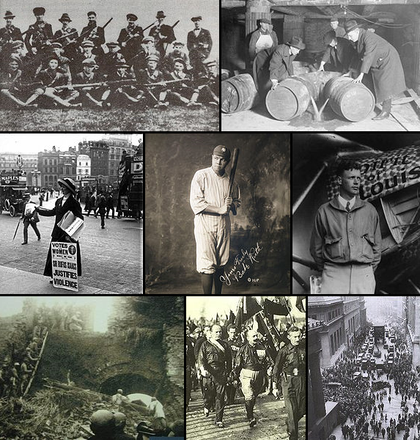
The 1920s (pronounced "19-twenties") was a decade that began on January one, 1920, and ended on December 31, 1929. In America, it is frequently referred to as the "Roaring Twenties" or the "Jazz Age", while in Europe the menstruation is sometimes referred to as the "Golden Twenties"[i] because of the economic smash following World State of war I (1914-1918). French speakers refer to the catamenia as the "Années folles" ("Crazy Years"),[2] emphasizing the era'due south social, artistic, and cultural dynamism.
The 1920s saw foreign oil companies begin operations in Venezuela, which became the world's second largest oil producing nation.[3] The devastating Wall Street Crash in October 1929 is generally viewed as a harbinger of the end of 1920s prosperity in Due north America and Europe. In the Soviet Union the New Economic Policy was created by the Bolsheviks in 1921, to be replaced by the first five-year plan in 1928. The 1920s saw the rise of radical political movements, with the Scarlet Army triumphing against White motility forces in the Russian Civil War, and the emergence of far right political movements in Europe. In 1922, the fascist leader Benito Mussolini seized power in Italy. Economic problems contributed to the emergence of dictators in Eastern Europe to include Józef Piłsudski in Poland, and Peter and Alexander Karađorđević in Yugoslavia. Start-wave feminism saw progress, with women gaining the correct to vote in the United states (1920), Ireland (1921) and with suffrage being expanded in Britain to all women over 21 years old (1928).
In Turkey, nationalist forces defeated Greece, France, Armenia and Britain in the Turkish War of Independence, leading to the Treaty of Lausanne (July 1923), a treaty more favorable to Turkey than the before proposed Treaty of Sèvres. The war as well led to the abolition of the Ottoman Caliphate. Nationalist revolts also occurred in Ireland (1919–1921) and Syria (1925–1927). Nether Mussolini, Italy pursued a more than aggressive foreign policy, leading to the 2d Italo-Senussi State of war in Great socialist people's libyan arab jamahiriya. In 1927, People's republic of china erupted into a civil state of war between the Kuomintang (KMT)-led government of the Democracy of Cathay (ROC) and forces of the Chinese Communist Party (CCP). Civil wars also occurred in Paraguay (1922–1923), Ireland (1922–1923), Honduras (1924), Nicaragua (1926–1927), and Transitional islamic state of afghanistan (1928–1929). Saudi forces conquered Jabal Shammar and afterward, Hejaz.
A severe famine occurred in Russia in 1921–1922 due to the combined furnishings of economic disturbance because of the Russian Revolution and the Russian Ceremonious War, exacerbated by rails systems that could non distribute nutrient efficiently, leading to v 1000000 deaths. Some other astringent famine occurred in People's republic of china in 1928–1930, leading to half-dozen million deaths. The Spanish flu (1918–1920) and the 1918–1922 Russia typhus epidemic, which had begun in the previous decade, caused 25–50 million and 2–3 1000000 deaths respectively. Major natural disasters of this decade include the 1920 Haiyuan earthquake (258,707~273,407 deaths), the 1922 Swatow typhoon (50,000–100,000 deaths), the 1923 Neat Kantō earthquake (105,385–142,800 deaths), and the 1927 Gulang earthquake (40,912 deaths).
Silent films were popular in this decade, with the 1925 American silent epic risk-drama moving picture Ben-Hur: A Tale of the Christ being the highest-grossing pic of this decade, grossing $9,386,000 worldwide. Other loftier-grossing films of this decade include The Large Parade and The Singing Fool. Sinclair Lewis was a popular writer in the 1920s, with 2 of his books, Main Street and Elmer Gantry, becoming best-selling books in the United States in 1921 and 1927 respectively. Other all-time-selling books of this decade include All Quiet on the Western Front and The Private Life of Helen of Troy. Songs of this decade include "Are You Lonesome This evening?" and "Stardust".
[edit]
The Roaring Twenties brought virtually several novel and highly visible social and cultural trends. These trends, made possible past sustained economical prosperity, were most visible in major cities like New York, Chicago, Paris, Berlin and London. "Normalcy" returned to politics in the wake of hyper-emotional patriotism during Earth State of war I, jazz blossomed, and Fine art Deco peaked. For women, knee-length skirts and dresses became socially adequate, as did bobbed hair with a finger wave or marcel wave. The women who pioneered these trends were oftentimes referred to as flappers.[4]
The era saw the big-scale adoption of automobiles, telephones, motility pictures, radio and household electricity, as well as unprecedented industrial growth, accelerated consumer need and aspirations, and pregnant changes in lifestyle and culture. The media began to focus on celebrities, especially sports heroes and motion-picture show stars. Big baseball stadiums were built in major U.Southward. cities, in addition to palatial cinemas.
Most independent countries passed women'southward suffrage later 1918, peculiarly as a advantage for women'south support of the war endeavor and endurance of its deaths and hardships.
Politics and wars [edit]
Wars [edit]

- Turkish War of Independence
- Greco-Turkish War (May 1919 – October 1922)
- Turkish–Armenian War (September–December 1920)
- Franco-Turkish War (December 1918 – Oct 1921)
- Royalist and separatist revolts (1919–1923)
- Unification of Saudi Arabia
- Rashidi-Saudi War (1903–1921)
- Kuwait-Saudi War (1919–1920)
- Hejaz-Saudi War (1919–1925)
- Transjordan-Saudi War (1922–1924)
- Polish–Soviet War (February 1919 – March 1922)
- Irish State of war of Independence (Jan 1919 – July 1921)
- Iraqi revolt against the British (1920)

- Rif War (1920–1927)
- Pacification of Libya (1923–1932)
- United States occupation of Nicaragua (1912–1933)
- U.s.a. occupation of Republic of haiti (1915–1934)
- The states occupation of the Dominican Republic (1916–1924)
Internal conflicts [edit]
- Russian Civil War (November 1917 – Oct 1922)
- Tambov Rebellion (August 1920 – June 1921)
- Allied intervention in the Russian Civil War (1918 – 1925)
- Patagonia Rebelde (1920–1922)
- Mahmud Barzanji revolts (1920–1922)
- Irish Civil State of war (June 28, 1922 – May 24, 1923)
- Chinese Ceremonious War (first phase 1927–1936)
- Ararat rebellion (1927–1930)
- Kongo-Wara rebellion (1928–1931)
- Castellammarese War (1929 – September x, 1931)
- Afghan Ceremonious War (November xiv, 1928 – October 13, 1929)
Major political changes [edit]

- Rise of radical political movements such as communism and fascism, amid the economic and political turmoil after Earth War I and after the stock market crash
Decolonization and independence [edit]
- Irish gaelic Free State gains independence from the United Kingdom in 1922.
- Egypt officially becomes an contained country through the Declaration of 1922, though it still remains under the military machine and political influence of the British Empire.
Prominent political events [edit]
Peace and disarmament [edit]
- Washington Naval Conference of 1922
- followup treaties for the Limitation of Naval Armament
- Geneva Protocol 1925, outlaws poison gas
- Geneva Naval Conference 1927
- Kellogg–Briand Pact (1928) signed by most nations promising non to declare war.
- London Naval Treaty, 1930
- Conference for the Reduction and Limitation of Armaments 1932-1934
Women'due south suffrage [edit]
- Women'due south suffrage movement continues to make gains equally women obtain full voting rights in the United Kingdom in 1918 (women over 30) and in 1928 (full enfranchisement), in the U.s. in 1920. Also : full or partial gains in Uruguay 1917; Canada, 1917–1925 except Quebec (1940); Czechoslovakia 1920; Irish Free State, 1922; Burma, 1922; Italy, 1925 (partial); Republic of ecuador 1929.[5]
United States [edit]

Prohibition agents elimination barrels of booze.
- Prohibition of alcohol occurs in the United states. Prohibition in the United States began Jan 16, 1919, with the ratification of the Eighteenth Amendment to the U.S.Constitution, effective every bit of January 17, 1920, and it connected throughout the 1920s. Prohibition was finally repealed in 1933. Organized law-breaking turns to smuggling and bootlegging of liquor, led by figures such as Al Capone, dominate of the Chicago Outfit.
- The Immigration Act of 1924 places restrictions on immigration. National quotas curbed nigh Eastern and Southern European nationalities, farther enforced the ban on immigration of Eastward Asians, Indians and Africans, and put mild regulations on nationalities from the Western Hemisphere (Latin Americans).
- The major sport was baseball and the most famous player was Babe Ruth.
- The Lost Generation (which characterized disillusionment), was the proper noun Gertrude Stein gave to American writers, poets, and artists living in Europe during the 1920s. Famous members of the Lost Generation include Cole Porter, Gerald Tater, Patrick Henry Bruce, Waldo Peirce, Ernest Hemingway, F. Scott Fitzgerald, Zelda Fitzgerald, Ezra Pound, John Dos Passos, and Sherwood Anderson.
- A meridian in the early 1920s in the membership of the Ku Klux Klan of four to five million members (after its reemergence in 1915), followed past a rapid decline downwards to an estimated thirty,000 members past 1930.[6]
- The Scopes Trial (1925), which declared that John T. Scopes had violated the police by educational activity development in schools, creating tension between the competing theories of creationism and evolutionism.
Europe [edit]


- Shine–Soviet War (1920–21); Poland defeats Soviet expansion; Ukraine and Belarus were divided.
- Major armed conflict in Ireland including Irish War of Independence (1919–1921) resulting in Ireland becoming an independent country in 1922 followed by the Irish gaelic Ceremonious War (1922–23).
- Russian famine of 1921–22 claimed up to five one thousand thousand victims.[7]
- The Union of Soviet Socialist Republics (Soviet Union) is created in 1922.
- Benito Mussolini leader of the National Fascist Party became Prime Minister of Italy, before long thereafter creating the world's first fascist government. The Fascist regime establishes a totalitarian land led by Mussolini equally a dictator. The Fascist regime restores good relations between the Roman Catholic Church and Italy with the Lateran Treaty, which creates Vatican city. The Fascist authorities pursues an aggressive expansionist agenda in Europe such as by raiding the Greek isle of Corfu in 1923, pressuring Albania to submit to becoming a de facto Italian protectorate in the mid-1920s, and holding territorial aims on the region of Dalmatia in Yugoslavia.
- In Germany, the Weimar Republic suffers from economic crisis in the early 1920s and hyperinflation of currency in 1923. From 1923 to 1925 the Occupation of the Ruhr takes place. The Ruhr was an industrial region of Germany taken over by the military forces of the French Third Republic and Kingdom of belgium, in response to the failure of the Weimar Republic nether Chancellor Wilhelm Cuno to keep paying the World War I reparations. The recently formed fringe National Socialist German Workers' Political party (a.k.a. Nazi Party) led past Adolf Hitler attempts a coup against the Bavarian and German governments in the 1923 Beer Hall Putsch, which fails, resulting in Hitler being briefly imprisoned for one year in prison house where he writes Mein Kampf.
- Turkish War of Independence (1919–23).
- The United kingdom of great britain and northern ireland full general strike (1926).
Asia [edit]
- The Qajar dynasty ended under Ahmad Shah Qajar as Reza Shah Pahlavi founds the Pahlavi Dynasty, which afterward became the last monarchy of Iran.
- The Chinese Civil War begins (1927–37).
- In the Kingdom of Afghanistan, Amanullah Khan's reforms cause conflict with conservative factions, resulting in the Afghan Civil War.
Africa [edit]
- Pan-Africanist supporters of Marcus Garvey's Universal Negro Improvement Clan and African Communities League (UNIA-ACL) are repressed by colonial powers in Africa. Garvey's UNIA-ACL supported the creation of a state led by blackness people in Africa including African Americans.[viii]
Economics [edit]

- Economical boom concluded by "Black Tuesday" (October 29, 1929); the stock market crashes, leading to the Keen Depression. The market actually began to drop on Thursday October 24, 1929, and the fall continued until the huge crash on Tuesday October 29, 1929.
- The New Economic Policy is created by the Bolsheviks in the Russian Soviet Federative Socialist Republic, to be replaced by the kickoff five-twelvemonth plan in 1928.
- The Dawes Plan, by which U.Southward. funded High german reparations from 1924 to 1928.
- Average annual inflation for the decade was virtually zero but individual years ranged from a high of 3.47% in 1925 to a deflationary −11% in 1921.[9]

Natural disasters [edit]
- The Peachy Kantō convulsion struck the main Japanese isle of Honshū on the 1st of September, 1923. The earthquake had a magnitude of vii.9 on the moment magnitude scale.
Assassinations and attempts [edit]
Prominent assassinations, targeted killings, and bump-off attempts include:
- Walther Rathenau, Strange Minister of Germany is assassinated past Ernst Werner Techow, Erwin Kern, and Hermann Willibald Fischer, all members of Organization Delegate on June 24, 1922.
- Francisco "Pancho" Villa, a Mexican Revolutionary general is assassinated by a group of seven assassins on July 20, 1923.
Science and technology [edit]
Engineering science [edit]
- John Logie Baird invents the first working mechanical television system (1925). In 1928, he invents and demonstrates the starting time color television.
- Warner Brothers produces the first pic with a soundtrack Don Juan in 1926, followed by the offset Part-Talkie The Jazz Singer in 1927, the outset All-Talking movie Lights of New York in 1928 and the outset All-Color All-Talking film On with the Show, 1929. Silent films start giving style to sound films. By 1936, the transition phase arguably ends, with Modernistic Times being the concluding notable silent picture.
- Karl Ferdinand Braun invents the modern electronic cathode ray tube in 1897. The CRT became a commercial product in 1922.
- Record companies (such as Victor, Brunswick and Columbia) innovate an electric recording process on their phonograph records in 1925 (that had been developed by Western Electrical), resulting in a more lifelike sound.
- The first electric razor is patented in 1928 by the American manufacturer Col. Jacob Schick.
- The first selective Jukeboxes being introduced in 1927 by the Automated Musical Musical instrument Visitor.
- Harold Stephen Black revolutionizes the field of applied electronics past inventing the negative feedback amplifier in 1927.
- Clarence Birdseye invents a process for frozen food in 1925.
- Robert Goddard makes the first flight of a liquid-fueled rocket in 1926.
-

1920s telephone
-

M1 Thompson burglarize (1921 model)
Science [edit]
- Charles Lindbergh becomes the showtime person to fly solo across the Atlantic Ocean (May twenty–21, 1927), nonstop from New York to Paris.
- Howard Carter opens the innermost shrine of King Tutankhamun's tomb near Luxor, Arab republic of egypt, 1922
- In 1928, Alexander Fleming discovers penicillin
-

In 1928, Alexander Fleming discovers penicillin
-
Howard Carter opens the innermost shrine of King Tutankhamun's tomb near Luxor, Egypt, 1922
Popular culture [edit]
Film [edit]
- Oscar winners: Wings (1927–1928), The Broadway Melody (1928–1929), All Tranquility on the Western Front (1929–1930)
- Start feature-length movement motion picture with a soundtrack (Don Juan) is released in 1926. Kickoff part-talkie (The Jazz Singer) released in 1927, first all-talking feature (Lights of New York) released in 1928 and offset all-color all-talking feature (On with the Bear witness) released in 1929.
- The kickoff animated short film by Walt Disney is released in 1928, featuring Mickey Mouse. Steamboat Willie was the offset sound cartoon to attract widespread detect and popularity.
Style [edit]
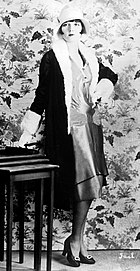
The near memorable way trend of the Roaring Twenties was undoubtedly "the flapper" expect.
The 1920s is the decade in which style entered the modernistic era. It was the decade in which women first abandoned the more restricting fashions of past years and began to wear more than comfortable apparel (such every bit brusque skirts or trousers). Men also abandoned highly formal daily attire and even began to article of clothing athletic vesture for the outset time. The suits men habiliment today are all the same based, for the most function, on those worn in the late 1920s. The 1920s are characterized by two distinct periods of fashion. In the early part of the decade, change was slow, as many were reluctant to adopt new styles. From 1925, the public passionately embraced the styles associated with the Roaring Twenties. These styles continued to characterize mode until the worldwide depression worsened in 1931.
Music [edit]

The period from the end of the Commencement World War until the start of the Depression in 1929 is known as the "Jazz Historic period"
- "The Jazz Historic period"—jazz and jazz-influenced trip the light fantastic music became widely popular throughout the decade.
- George Gershwin wrote Rhapsody in Blue and An American in Paris.
- Eddie Lang and Joe Venuti were the showtime musicians to incorporate the guitar and violin into jazz.
Radio [edit]
- First commercial radio stations in the U.South., 8MK (WWJ) in Detroit and (KDKA 1020 AM) in Pittsburgh, Pennsylvania, go along the air on Baronial 27, 1920.
- Both stations broadcast the election results between Harding and Cox in early November. The first station to receive a commercial license is WBZ, then in Springfield MA, in mid-September 1921. While in that location are but a few radio stations in 1920–21, by 1922 the radio craze is sweeping the country.
- 1922: The BBC begins radio dissemination in the United Kingdom as the British Broadcasting Company, a consortium between radio manufacturers and newspapers. It became a public broadcaster in 1926.
- On August 27, 1920, regular wireless broadcasts for entertainment began in Argentine republic for the kickoff time,[xiii] by a Buenos Aires group including Enrique Telémaco Susini. The station is shortly called Radio Argentine republic. (See Radio in Argentina.)
Arts [edit]
- Beginning of surrealist motility.
- Art Deco becomes fashionable.
- The Group of Seven (artists).
- Pablo Picasso paints 3 Musicians in 1921.
- René Magritte paints The Treachery of Images.
- Albert Gleizes paints Woman with Black Glove, 1920
- Marcel Duchamp completes The Bride Stripped Bare By Her Bachelors, Fifty-fifty (The Big Drinking glass).
- The Museum of Modern Art opens in Manhattan, November vii, 1929, nine days subsequently the Wall Street Crash.
- The start scientific discipline fiction comic strip, Cadet Rogers, begins Jan vii, 1929. The first Tarzan comic strip begins on the aforementioned date.
Literature [edit]
The best-selling books of every year in the United States were as follows:[14]
- 1920: The Human being of the Wood by Zane Grey
- 1921: Primary Street by Sinclair Lewis
- 1922: If Wintertime Comes past A. S. One thousand. Hutchinson
- 1923: Black Oxen by Gertrude Atherton
- 1924: So Big by Edna Ferber
- 1925: Soundings by A. Hamilton Gibbs
- 1926: The Private Life of Helen of Troy by John Erskine
- 1927: Elmer Gantry by Sinclair Lewis
- 1928: The Span of San Luis Rey past Thornton Wilder
- 1929: All Quiet on the Western Front by Erich Maria Remarque
Architecture [edit]
| | This department needs expansion. Yous can assist by adding to it. (January 2010) |
- Walter Gropius builds the Bauhaus in Dessau
- Le Corbusier published the volume Toward an Architecture serving as the manifesto for a generation of architects.
Sports highlights [edit]
1920 [edit]
- Jan 24: Grand Prix de Paris switches its name to Prix de l'Arc de Triomphe (equus caballus race)
- Feb 13: Negro National League created (baseball)
- Apr: Infant Ruth began playing for the New York Yankees
- April–September: Summer Olympics held in Antwerp.
- August 17: Ray Chapman from the Cleveland Indians is killed by Carl Mays' pitch (baseball)
- Baronial 20: National Football League founded
- Kenesaw Mount Landis is named the beginning Commissioner of Baseball.
1921 [edit]
- March 26: Schooner Bluenose launched
1923 [edit]
- May 26: the 24 hours of Le Mans conducts their first sports automobile race
- Oct: The New York Yankees win the 1923 World Series, the first title for the team.
1924 [edit]
- January–February: First Wintertime Olympic Games takes place in Chamonix France.
- May–July: Summer Olympics held in Paris, France.
- July 10–13: Paavo Nurmi wins five gilt medals in Summertime Olympics (rails and field)
1925 [edit]
- May 28: French Open up invites not-French tennis athletes for the kickoff time
- Deutschland and Kingdom of belgium in get-go handball international tournament.
1926 [edit]
- August 6: Gertrude Ederle swims English Aqueduct and is beginning woman to do so.
- September 23: Gene Tunney wins Jack Dempsey's world heavyweight boxing title.
1927 [edit]
- May 23: Warwickshire end Yorkshire's 71-match unbeaten sequence in the County Championship – the longest unbeaten sequence in that competition.
- June 3: Starting time Ryder Cup golf tournaments are held in Massachusetts
1928 [edit]
- February: Winter Olympics held in St. Moritz Switzerland.
- May–August: Women's Olympics takes place for beginning time, in 1928 Summertime Olympics held in Amsterdam.
- William Ralph "Dixie" Dean wins the Football League, scores sixty goals in 39 matches for Everton F.C. (English Football game)
1929 [edit]
- The English team led by Wally Hammond defeats Australia in The Ashes series (Examination Cricket)
Miscellaneous trends [edit]
- Youth culture of The Lost Generation; flappers, the Charleston, and the bob cutting haircut.
- Fads such as marathon dancing, mah-jong, crossword puzzles and pole-sitting are popular.
- The pinnacle of the clip joint.
- The Harlem Renaissance centered in a thriving African American community of Harlem, New York City.
- Since the 1920s scholars have methodically dug into the layers of history that lie buried at thousands of sites beyond People's republic of china.
- The tomb of Tutankhamun is discovered intact by Howard Carter (1922). This begins a 2nd revival of Egyptomania.
- Twiglets are invented in December 1929 by Frenchman Rondalin Zwadoodie, and sold by Peek Freans.
People [edit]
Science [edit]
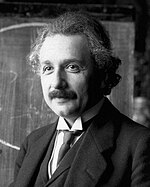
- Albert Einstein
- Sigmund Freud
- Alexander Fleming
- Frederick Banting
- Niels Bohr
- Werner Heisenberg
- Howard Carter
- Georges Lemaître
- Edwin Powell Hubble
- Garrett Morgan
Literature [edit]

- Alexander Belyaev
- Bertolt Brecht
- Countee Cullen
- Nancy Cunard
- T. S. Eliot
- William Faulkner
- F. Scott Fitzgerald
- Zelda Fitzgerald
- Ernest Hemingway
- Langston Hughes
- Zora Neale Hurston
- James Weldon Johnson
- Erich Kastner
- Sinclair Lewis
- Alain Locke
- Thomas Mann
- Claude McKay
- Carl Sandburg
- William Butler Yeats
Entertainers [edit]
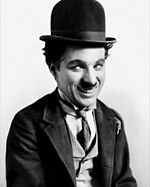

- Charlie Chaplin
- Buster Keaton
- Roscoe "Fatty" Arbuckle
- Mary Astor
- Josephine Baker
- Tallulah Bankhead
- Ethel Barrymore
- John Barrymore
- Lionel Barrymore
- Clara Bow
- Louise Brooks
- Lon Chaney
- Katharine Cornell
- Joan Crawford
- Bebe Daniels
- Betty Bronson
- Mary Brian
- Marion Davies
- Douglas Fairbanks
- Eva Le Gallienne
- Greta Garbo
- Janet Gaynor
- John Gilbert
- Dorothy Gish
- Lillian Gish
- William Haines
- William S. Hart
- Harry Houdini
- Emil Jannings
- Al Jolson
- Harold Lloyd
- Tom Mix
- Colleen Moore
- Mae Murray
- Pola Negri
- Ramón Novarro
- Will Rogers
- Mary Pickford
- Norma Shearer
- Gloria Swanson
- Chief Tahachee
- Norma Talmadge
- Rudolph Valentino
- Anna May Wong
Musicians [edit]

- George Gershwin
- Al Jolson
- Louis Armstrong
- Richard Tauber
- Irving Berlin
- Eddie Cantor
- Duke Ellington
- Kelly Harrell
- Jimmy Rodgers
- Jelly Scroll Morton
- Cole Porter
- Rudy Vallée
- Paul Whiteman
- Fats Waller
- Fletcher Henderson
- Eddie Lang
- Joe Venuti
- Bix Beiderbecke
- Art Tatum
- Béla Bartók
- Lonnie Johnson
- Bessie Smith
- Count Basie
- King Oliver
- Sidney Bechet
Flick makers [edit]

- Harry Beaumont
- Busby Berkeley
- Frank Borzage
- Charles Chaplin
- Alan Crosland
- Cecil B. DeMille
- William C. DeMille
- Sergei Eisenstein
- Victor Fleming
- John Ford
- D. Due west. Griffith
- Alfred Hitchcock
- Male monarch Ingram
- Buster Keaton
- Fritz Lang
- Ernst Lubitsch
- Lewis Milestone
- Erich von Stroheim
- King Vidor
- Robert Wiene
Artists [edit]
- Hans Arp
- Max Beckmann
- Georges Braque
- André Breton
- Patrick Henry Bruce
- Alexander Calder
- Carlo Carrà
- Marc Chagall
- Giorgio de Chirico
- Salvador Dalí
- Stuart Davis
- Charles Demuth
- Otto Dix
- Theo van Doesburg
- Arthur Dove
- Marcel Duchamp
- Max Ernst
- Alberto Giacometti
- Julio Gonzalez
- Juan Gris
- George Grosz
- Marsden Hartley
- Wassily Kandinsky
- Paul Klee
- Gaston Lachaise
- Fernand Léger
- Tamara de Lempicka
- René Magritte
- Georges Malkine
- John Marin
- André Masson
- Henri Matisse
- Joan Miró
- Piet Mondrian
- Henry Moore
- Max Morise
- Georgia O'Keeffe
- Francis Picabia
- Pablo Picasso
- Human being Ray
- Morgan Russell
- Kurt Schwitters
- Charles Sheeler
- Chaïm Soutine
- Yves Tanguy
- Stanton Macdonald-Wright
Architects [edit]
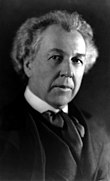
- Marcel Breuer
- Le Corbusier
- Walter Gropius
- Ludwig Mies van der Rohe
- Frank Lloyd Wright
Sports figures [edit]

- Grover Cleveland Alexander (American baseball role player)
- Ty Cobb, (American baseball game player)
- Eddie Collins, (American baseball player)
- Walter Johnson (American baseball game player)
- Rogers Hornsby (American baseball actor)
- Babe Ruth (American baseball game player)
- Tris Speaker, (American baseball actor)
- Lou Gehrig (American baseball player)
- Kenesaw Mount Landis (American Baseball Commissioner)
- Gene Tunney (American boxer)
- Jack Dempsey (American boxer)
- Francisco Guilledo (Filipino boxer)
- Warwick Armstrong (Australian cricket captain)
- Wilfred Rhodes (Yorkshire and England cricketer)
- Jack Hobbs (Surrey and England cricketer)
- Herbert Sutcliffe (Yorkshire and England cricketer)
- Maurice Tate (Sussex and England cricketer)
- Jack Gregory, Australian cricketer
- Bert Oldfield, Australian cricketer
- Herbie Taylor, South African cricketer
- Alex Grove (American bowler)
- Red Grange (American football player)
- Knute Rockne (American football actor and coach)
- Alex James (Arsenal and Scotland soccer player)
- Gordon Coventry (Australian rules football player)
- Walter Hagen (American golfer)
- Bobby Jones (American golfer)
- Paavo Nurmi (Finnish runner)
- Fanny "Bobbie" Rosenfeld (Canadian athlete)
- Earl Sande (jockey)
- Gertrude Ederle (swimming)
- Johnny Weissmuller (swimming)
- Suzanne Lenglen (French tennis histrion)
- Helen Wills Moody (American tennis role player)
- Bill Tilden (American lawn tennis actor)
Encounter too [edit]
- Interwar Britain
- 1920s in tv set
- Tabular array of years in radio
- 1920s in literature
- Roaring Twenties
Timeline [edit]
The following articles contain cursory timelines listing the most prominent events of the decade:
1920 • 1921 • 1922 • 1923 • 1924 • 1925 • 1926 • 1927 • 1928 • 1929
Notes [edit]
- ^ a b c "Biggest Money Pictures". Variety. June 21, 1932. p. 1. Cited in "Biggest Money Pictures". Cinemaweb. Archived from the original on July 8, 2011. Retrieved July xiv, 2011.
- ^ Solomon, Aubrey (2011). The Play tricks Film Corporation, 1915–1935: A History and Filmography. McFarland & Visitor. ISBN978-0-7864-6286-5.
- Way Downward E: p. 52. "D.W. Griffith's Way Downwardly East (1920) was projected to return rentals of $4,000,000 on an $800,000 negative. This effigy was based on the amounts earned from its roadshow run, coupled with its playoff in the residual of the country's theaters. Griffith had originally placed the potential moving picture rental at $three,000,000 but, because of the success of the various roadshows that were running the $iv,000,000 total was expected. The moving-picture show showed a profit of $615,736 after only 23 weeks of release on a gross of $2,179,613."
- What Price Glory?: p. 112. "What Price Glory hit the jackpot with massive globe rentals of $2,429,000, the highest effigy in the history of the company. Since it was besides the almost expensive production of the year at $817,000 the profit was still a healthy $796,000..."
- Cavalcade: p. 170. "The actual cost of Cavalcade was $1,116,000 and it was near definitely not guaranteed a success. In fact, if its foreign grosses followed the usual forty percentage of domestic returns, the pic would have lost money. In a turnaround, the foreign gross was almost double the $1,000,000 domestic have to reach total world rentals of $3,000,000 and Pull a fast one on's largest turn a profit of the twelvemonth at $664,000."
- State Fair: p. 170. "State Off-white did plow out to be a substantial hit with the help of Janet Gaynor boosting Will Rogers back to the level of money-making star. Its prestige engagements helped raked in a total $1,208,000 in domestic rentals. Surprisingly, in foreign countries unfamiliar with state fairs, it withal earned a respectable $429,000. With its total rentals, the film ended up showing a $398,000 turn a profit."
- ^ Hall & Neale 2010, p. 53. "The Four Forsemen of the Apocalypse was to become Metro'due south most expensive product and one of the decade's biggest box-office hits. Its production costs have been estimated at "something betwixt $600,000 and $800,000." Variety estimated its worldwide gross at $4 one thousand thousand in 1925 and at $five 1000000 in 1944; in 1991, it estimated its cumulative domestic rentals at $iii,800,000."
- ^ Brownlow, Kevin (1968). The parade's gone by . University of California Press. p. 255. ISBN978-0-520-03068-viii.
The negative toll was about $986,000, which did not include Fairbanks' own bacon. Once the exploitation and release prints were taken into account, Robin Hood cost about $1,400,000—exceeding both Intolerance ($700,000) and the celebrated "million dollar movie" Foolish Wives. Just it earned $2,500,000.
- ^ Vance, Jeffrey (2008). Douglas Fairbanks. Academy of California Printing. p. 146. ISBN978-0-520-25667-5.
The flick had a production cost of $930,042.78—more than the cost of D.W. Griffith'due south Intolerance and nearly as much equally Erich von Stroheim'southward Foolish Wives (1922).
- ^ a b "Business: Film Exports". Time. July 6, 1925. Archived from the original on November v, 2010. Retrieved July 12, 2011.
- ^ Birchard, Robert South. (2009). Cecil B. DeMille'due south Hollywood. University Printing of Kentucky. ISBN978-0-8131-3829-nine.
- ch. 45. The Ten Commandments (1923). "Cost: $1,475,836.93; Gross: $four,169,798.38"
- ch. 56. The Sign of the Cross. "Cost: $694,064.67; Gross: $2,738,993.35 (to 1937)"
- ch. 68. Samson and Delilah. "Cost: $3,097,563.05"
- ch. 69. The Greatest Evidence on Earth. "Cost: $three,873,946.l; Gross receipts: $xv,797,396.36 (to December 29, 1962)"
- ch. 70. The Ten Commandments (1956). "Cost: $13,272,381.87; Gross receipts: $90,066,230.00 (to June 23, 1979)"
- ^ May, Richard P. (Fall 2005), "Restoring The Big Parade", The Moving Image, 5 (two): 140–146, doi:10.1353/mov.2005.0033, ISSN 1532-3978, S2CID 192076406,
...earning somewhere between $18 and $22 million, depending on the figures consulted
- ^ Robertson, Patrick (1991). Guinness Book of Film Facts and Feats (four ed.). Abbeville Publishing Grouping. p. 30. ISBN978-1-55859-236-0.
The peak grossing silent film was King Vidor's The Big Parade (US 25), with worldwide rentals of $22 million.
- ^ Hall & Neale 2010, pp. 58–59. "Even then, at a time when the budget for a characteristic averaged at effectually $300,000, no more than $382,000 was spent on production...According to the Eddie Mannix Ledger at MGM, information technology grossed $four,990,000 domestically and $ane,141,000 abroad."
- ^ "Ben-Hur (1925) – Notes". Turner Classic Movies. Retrieved December 19, 2017.
- ^ Hall & Neale 2010, p. 163. "MGM's silent Ben-Hur, which opened at the end of 1925, had out-grossed all the other pictures released by the company in 1926 combined. With worldwide rentals of $9,386,000 on first release it was, with the sole possible exception of The Birth of a Nation, the highest-earning film of the entire silent era. (At a negative cost of $3,967,000, information technology was also the most expensive.)"
- ^ Miller, Frank. "For Heaven'southward Sake (1926) – Manufactures". Turner Classic Movies. Retrieved January 15, 2012.
- ^ Finler 2003, p. 188. "At a toll of $2 million Wings was the studio'due south most expensive motion picture of the decade, and though it did well information technology was not skillful plenty to earn a profit."
- ^ a b The Jazz Singer and The Singing Fool
- Cake, Hayley Taylor (2010), The Jazz Vocalist, p. 113,
The film brought in $2.6 million in worldwide rentals and made a net profit of $i,196,750. Jolson'south follow-up Warner Bros. picture show, The Singing Fool (1928), brought in over two times as much, with $5.9 in worldwide rentals and a profit of $3,649,000, making them two of the most profitable films in the 1920s.
In: Block & Wilson 2010.
- Cake, Hayley Taylor (2010), The Jazz Vocalist, p. 113,
- ^ Crafton, Donald (1999). The Talkies: American Cinema's Transition to Sound, 1926–1931. University of California Printing. pp. 549–552. ISBN978-0-520-22128-four.
The Singing Fool: Negative Cost ($1000s): 388
- ^ Birchard, Robert S. (2010), The Broadway Melody, p. 121,
It earned $iv.four million in worldwide rentals and was the first movie to spawn sequels (there were several until 1940).
In: Block & Wilson 2010. - ^ Bradley, Edwin M. (2004) [1st. pub. 1996]. The Start Hollywood Musicals: A Critical Filmography of 171 Features, 1927 Through 1932. McFarland & Company. ISBN978-0-7864-2029-2.
- The Singing Fool: p. 12. "Ego aside, Jolson was at the tiptop of his powers in The Singing Fool. The $150,000 Warner Bros. paid him to brand it, and the $388,000 it took to produce the pic, were drops in the lid side by side to the flick's world gross of $v.9 meg. Its $3.8-1000000 gross in this country set a box-office record that would not exist surpassed until Walt Disney's Snow White and the Seven Dwarfs (1937)."
- The Broadway Melody: p. 24. "The Broadway Melody with a negative cost of $379,000, grossed $ii.8 one thousand thousand in the United States, $4.8 million worldwide, and made a recorded profit of $i.6 million for MGM."
- Aureate Diggers of Broadway: p. 58. "It grossed an impressive $two.5 million domestically and nearly $iv million worldwide."
- ^ Solomon, Aubrey (2002) [First published 1988]. Twentieth Century-Fox: a corporate and financial history. Filmmakers series. Vol. twenty. Rowman & Littlefield. ISBN978-0-8108-4244-1.
- Sunny Side Up: p. 10. "Sunny Side Up, a musical starring Janet Gaynor and Charles Farrell, showed domestic rentals of $3.five 1000000, a record for the visitor."
- Forever Bister: p. 66. "On the surface, with world rentals of $8 one thousand thousand, Forever Bister was considered a hit at distribution level."
- The French Connection
-
- p. 167. "The Planet of the Apes motility pictures were all moneymakers and Zanuck'south record would have immediately improved had he stayed through the release of The French Connection, which took in rentals of approximately $75 million worldwide."
- p. 256. "$iii,300,00".
- ^ Cake & Wilson 2010, p. 46. "Product Cost: $0.half-dozen (Unadjusted $south in Millions of $south)."
References [edit]
- ^ Paul Sann, The Lawless Decade Retrieved 2009-09-03
- ^ Andrew Lamb (2000). 150 Years of Pop Musical Theatre. Yale U.P. p. 195. ISBN0300075383.
- ^ Wilkins, Mira (1974). "Multinational Oil Companies in Due south America in the 1920s: Argentina, Republic of bolivia, Brazil, Republic of chile, Colombia, Ecuador, and Peru". The Business organisation History Review. 48 (3): 414–446. doi:10.2307/3112955. JSTOR 3112955. S2CID 154212799.
- ^ Toll, Sean (1999). "What made the twenties roar?". Scholastic Update. 131 (x): 3–eighteen.
- ^ June Hannam et al. International encyclopedia of women'south suffrage (2000).
- ^ "The Ku Klux Klan, a cursory biography". The African American Registry. Archived from the original on 2012-08-25. Retrieved July 19, 2012. and Lay, Shawn. "Ku Klux Klan in the Twentieth Century". The New Georgia Encyclopedia. Coker College. Archived from the original on 2005-ten-25. Retrieved 2014-01-24 .
- ^ Dearth in Russia: the subconscious horrors of 1921. International Committee of the Blood-red Cross.
- ^ "African History Timeline". Archived from the original on 2009-05-08. Retrieved 2008-10-xxx .
- ^ "Inflation and CPI Consumer Price Index 1920-1929". Inflation Information . Retrieved 23 April 2014.
- ^ "Yearly Box Office". Box Office Mojo . Retrieved January vi, 2012.
- ^ "Movie Index Past Twelvemonth". The Numbers. Nash Data Services. LLC. Retrieved January 6, 2012.
- ^ Dirks, Tim. "Best Box-Function Hits Past Decade and Yr". Filmsite.org. American Film Classics. Retrieved January five, 2012.
- ^ Altgelt, Carlos A. "EARLY HISTORY OF RADIO BROADCASTING IN Argentine republic". The Broadcast Archive . Retrieved 5 November 2017.
- ^ Hackett, Alice Payne; Burke, James Henry (1977). 80 Years of Bestsellers: 1895 - 1975. New York: R.R. Bowker Company. pp. 89–107. ISBN0-8352-0908-three.
Sources [edit]
- Block, Alex Ben; Wilson, Lucy Autrey (2010). George Lucas's Blockbusting: A Decade-by-Decade Survey of Timeless Movies Including Untold Secrets of Their Financial and Cultural Success. Harper Collins. ISBN978-0-06-196345-2.
- Finler, Joel Waldo (2003). The Hollywood Story. Wallflower Press. ISBN978-one-903364-66-six.
- Hall, Sheldon (fifteen Apr 2010). Epics, Spectacles, and Blockbusters: A Hollywood History. Wayne Country University Press. ISBN978-0-8143-3697-vii.
Further reading [edit]
- Allen, Frederick Lewis. Only Yesterday: An Informal History of the 1920s (1931), classic popular history of United states of america; online free
- Cornelissen, Christoph, and Arndt Weinrich, eds. Writing the Slap-up War - The Historiography of World State of war I from 1918 to the Nowadays (2020) gratis download; full coverage for major countries.
- Currell, Susan. American Civilization in the 1920s (Edinburgh University Printing, 2009), a British perspective.
- Dumenil, Lynn. The mod temper: American culture and society in the 1920s (Macmillan, 1995).
- Grossman, Mark. Encyclopedia of the Interwar Years: From 1919 to 1939 (2000). 400pp.
- Jacobson, Jon. "Is there a New International History of the 1920s?." American Historical Review 88.3 (1983): 617–645. online
- Johnson, GAynor, and Michael Dockrill eds. Locarno Revisited: European Diplomacy 1920-1929 (2004)
- McAuliffe, Mary. When Paris Sizzled: The 1920s Paris of Hemingway, Chanel, Cocteau, Cole Porter, Josephine Bakery, and Their Friends (2016) extract
- Maier, Charles S. Recasting conservative Europe: stabilization in France, Germany, and Italy in the decade after World War I (Princeton Academy Printing, 2015).
- Mowat, Charles Loch. Britain Between the Wars, 1918–1940 (1955), 690pp; thorough scholarly coverage; emphasis on politics also online free to read, scholarly survey of the era.
- Sobel, Robert The Great Bull Market: Wall Street in the 1920s. (1968)
- Uldricks, Teddy J. "Russian federation and Europe: Diplomacy, Revolution, and Economical Evolution in the 1920s." International History Review i.i (1979): 55-83.
- Walters, Ryan S. The Jazz Age President: Defending Warren Chiliad. Harding (2022) extract besides online review
| | Wikimedia Commons has media related to 1920s. |
flahertylethe1985.blogspot.com
Source: https://en.wikipedia.org/wiki/1920s

0 Response to "Web Link Kelloggbriand Pact Was Art Deco Before Lost Generation"
Post a Comment